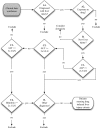Evaluation considerations for EHR-based phenotyping algorithms: A case study for drug-induced liver injury
- PMID: 24303321
- PMCID: PMC3814479
Evaluation considerations for EHR-based phenotyping algorithms: A case study for drug-induced liver injury
Abstract
Developing electronic health record (EHR) phenotyping algorithms involves generating queries that run across the EHR data repository. Algorithms are commonly assessed within demonstration studies. There remains, however, little emphasis on assessing the precision and accuracy of measurement methods during the evaluation process. Depending on the complexity of an algorithm, interim refinements may be required to improve measurement methods. Therefore, we develop an evaluation framework that incorporates both measurement and demonstration studies. We evaluate a baseline EHR phenotyping algorithm for drug induced liver injury (DILI) developed in collaboration with electronic Medical Records Genomics (eMERGE) network participants. We conduct a measurement study and report qualitative (i.e., perceptions of evaluation approach effectiveness) and quantitative (i.e., inter-rater reliability) measures. We also conduct a demonstration study and report qualitative (i.e., appropriateness of results) and quantitative (i.e., positive predictive value) measures. Given results from the measurement study, our evaluation approach underwent multiple changes including the addition of laboratory value visualization and an expanded review of clinical notes. Results from the demonstration study informed changes to our algorithm. For example, given the goal of eMERGE to identify patients who may have a genetic susceptibility to DILI, we excluded overdose patients.
Figures
References
-
- Aithal GP, Watkins PB, Andrade RJ, Larrey D, Molokhia M, Takikawa H, Hunt CM, Wilke RA, Avigan M, Kaplowitz N, et al. Case definition and phenotype standardization in drug-induced liver injury. Clin Pharmacol Ther. 2011;89(6):806–815. - PubMed
Grants and funding
LinkOut - more resources
Full Text Sources

